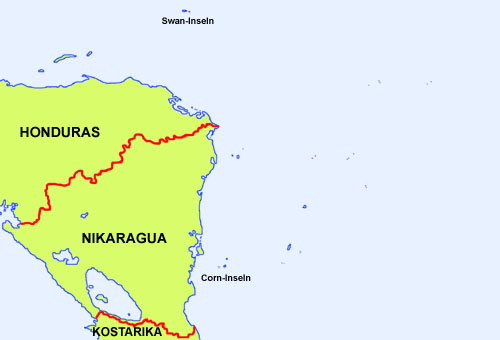mobile View, to the German Version tap the flag


- Territory of Honduras
- own names: Islas del Cisne or Islas Santanilla
• Flag
• Map
• Numbers and Facts
• History
• Ursprung des Namens der Inseln
The Swan Islands have no own flag.

Position of the Swan Islands:

Source: Volker Preuß

Area: 1,2 square miles, The Swan Islands are situated ca. 93 miles northeastern of the northern coast of Honduras in the Caribbean Sea. They consist of Great Swan Island (Isla Grande) and Little Swan Island (Isla Pequena).
Inhabitants: ca. 10 (2014)
official Language: Spanish
Currency: 1 Lempira (L) = 100 Centavos (Honduran currency)
Time Zone: GMT – 6 h
Source:
Wikipedia (DE)

The Swan Islands were discovered in 1502 by Columbus and named as Islas Santa Ana. The islands belonged indeed to Spain, but they will never had seen a Spaniard. They served for many years as a pirate nest. Finally they were occupied in 1860 by the US-American pirate William Walker. After Walkers death Honduras appropriated the islands officially in the year 1861.
The Corn Islands were probably discovered in the year 1502 by Columbus. The Spanish appropriated the islands indeed as Islas de los Manglares, but they did not colonize them so that they developed as a pirate nest of the Buccaneers and came after 1697 gradually under British influence.
Since the beginning of the 19th century there were projects to build a canal through the Isthmus of Central America. The most interested states have been Great Britain – the then great power in the Caribbean Sea – and the aspiring USA. Target of both powers was the appropriation of a land stripe between Atlantic and Pacific Ocean and the construction of a canal under own sovereignty. Great Britain possessed the Caribbean Islands and had secured with British-Honduras and the Mosquito Coast first territories on the mainland. In the Clayton-Bulwer Treaty from 1850 both countries agreed about the neutrality of a coming canal and to renounce further territorial appropriations. The USA appropriated in 1856 the Seranilla Bank, the Seraña Bank, the Quita Sueño Bank, the Roncador Cays, the Petrel Islands (Bajo Nuevo Bank) and Navassa Island, ostensibly because of its guano resources. The USA became active even on the American mainland. Great Britain leaved the Mosquito Coast and gave it to Honduras and Nicaragua. The Corn Islands were officially appropriated by Nicaragua in the year 1894.
The Isthmus of Panama was ideally for the Canal where Ferdinand Vicomte de Lesseps startet in the year 1879 with the construction works. There was however a project named "Trans-Nicaragua-Canal" which was accelerated by the USA. As Lesseps because of financial problems has to stop ist works on the Panama Canal in 1889 and the endeavours for a continue failed in 1899, acquired the USA in the year 1901 the exclusive right to complete the canal and occupyd over and above in 1905, 1907 and 1911 Honduras, and in 1912 Nicaragua. But Colombia would not cede the Panama Canal Zone to the USA, so that the USA strengthend the establishment of the Republic of Panama which ceded the canal zone to the USA. A evident break of the Clayton-Bulwer Treaty with Great Britain from 1860. The Panama Canal was inaugurated on 15th of August in 1914. The USA kept open the option for the "Trans-Nicaragua-Canal" because of the political difficulties with Colombia und Panama. In this way the Corn Islands were leased in 1914 for 99 years from Nicaragua and the Swan-Islands (Honduras) were occupied in 1924 by the USA to protect the military influence and both were developed as navy, radio and air force bases. As the Panama Canal was steady in the hand of the USA became the Corn Islands and also the Sawn Islands needless as bases, so that the USA terminated the leasing treaty earlier and left in 1971 the Corn Islands and the Swan Islands.
The Swan Islands served the USA as radio station and navy base especially during the Bay of Pigs Invasion and the Cuba Crisis. After 1972 Honduras used sporadically the military facilities on the islands. Except the military crew there lived and live here nowadays leastways one farmer and sometimes some fishermen.
Source:
Volker Preuß

The name "Swan Islands" is in use since 1775 and should go back to a Captain Swan.
Source:
Wikipedia (FR)


![]()


